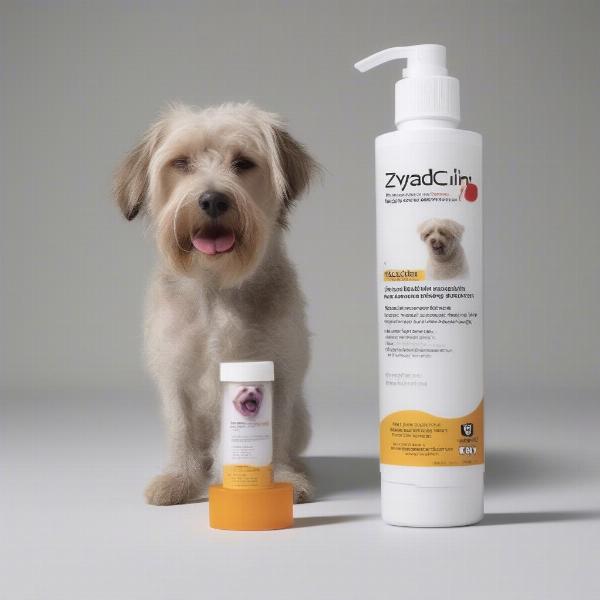Zydaclin, a topical antibiotic containing clindamycin, is sometimes prescribed for dogs suffering from certain skin infections. Understanding its uses, potential side effects, and proper administration is crucial for responsible pet ownership. This comprehensive guide will equip you with the knowledge you need to effectively use Zydaclin for your canine companion.
What is Zydaclin and How Does it Work?
Zydaclin is a brand name for a topical solution containing clindamycin phosphate. Clindamycin is an antibiotic belonging to the lincosamide class, which works by inhibiting bacterial protein synthesis. This prevents bacteria from growing and spreading, thus helping to clear up infections. It’s important to note that Zydaclin is specifically formulated for topical use on the skin and should not be administered orally or used in the eyes.
 Zydaclin Topical Solution for Dogs
Zydaclin Topical Solution for Dogs
When is Zydaclin Prescribed for Dogs?
Veterinarians typically prescribe Zydaclin to treat superficial bacterial skin infections in dogs, such as pyoderma. These infections often manifest as pimples, pustules, redness, and hair loss. Zydaclin is effective against a range of bacteria, including Staphylococcus and Streptococcus species, which are common culprits in canine skin infections. It’s crucial to remember that Zydaclin is not effective against viral or fungal infections. A proper diagnosis from a veterinarian is essential to determine the cause of the skin condition and ensure appropriate treatment.
How to Apply Zydaclin to Your Dog
Applying Zydaclin correctly is vital for its effectiveness. Always follow your veterinarian’s instructions carefully. Generally, the affected area should be cleaned and dried before applying a thin layer of the solution. Avoid applying Zydaclin near your dog’s eyes, mouth, or nose. Wash your hands thoroughly after application to prevent accidental ingestion.
Potential Side Effects of Zydaclin in Dogs
While generally safe, Zydaclin can occasionally cause side effects in some dogs. These are usually mild and may include:
- Mild skin irritation or redness at the application site
- Temporary hair loss
- Gastrointestinal upset (vomiting or diarrhea) if ingested
If your dog experiences any adverse reactions, discontinue use and contact your veterinarian immediately. Severe allergic reactions are rare but can occur.
Zydaclin Dosage and Treatment Duration
The dosage and duration of Zydaclin treatment will vary depending on the severity of the infection and your dog’s individual needs. Your veterinarian will determine the appropriate regimen for your dog. Never adjust the dosage or stop treatment prematurely without consulting your veterinarian, even if the infection seems to have cleared up. Premature discontinuation can lead to antibiotic resistance and recurrence of the infection.
What to Do If You Miss a Dose
If you miss a dose of Zydaclin, apply it as soon as you remember. However, if it’s close to the time for the next dose, skip the missed dose and continue with the regular schedule. Never double the dose to catch up.
Clindamycin Dog Dose and Zydaclin for Dogs
It’s essential to distinguish between clindamycin, the active ingredient, and Zydaclin, the brand-name topical solution. zydaclin for dogs refers specifically to the topical formulation. The clindamycin dog dose will be determined by your veterinarian and can vary depending on factors such as the type of infection, its severity, and your dog’s weight and overall health. Never administer oral clindamycin intended for human use to your dog.
Conclusion
Zydaclin can be an effective treatment for bacterial skin infections in dogs. By understanding how it works, following your veterinarian’s instructions carefully, and monitoring your dog for potential side effects, you can help ensure a successful outcome. Always consult your veterinarian for a proper diagnosis and treatment plan for any skin condition affecting your furry friend.
FAQs
- Can I use human clindamycin cream on my dog? No, never use human medications on your dog without consulting your veterinarian. The formulation and dosage may be different and could be harmful.
- How long does it take for Zydaclin to work? Improvement may be visible within a few days, but it’s important to complete the entire course of treatment as prescribed by your veterinarian.
- What should I do if my dog licks the Zydaclin? While small amounts are unlikely to cause serious harm, contact your veterinarian immediately.
- Can Zydaclin be used on puppies? Yes, but only under the guidance of a veterinarian.
- Is Zydaclin safe for pregnant or lactating dogs? Consult your veterinarian before using Zydaclin on pregnant or lactating dogs.
- Can Zydaclin be used with other medications? Inform your veterinarian about all other medications your dog is taking, including supplements, to avoid potential interactions.
- Where can I buy Zydaclin for my dog? Zydaclin requires a prescription from a veterinarian.
ILM Dog is your trusted resource for comprehensive, practical, and reliable information on all aspects of dog care. We provide expert advice on dog breeds, health, training, nutrition, grooming, and much more, catering to both novice and experienced dog owners worldwide. From puppy care to senior dog care, ILM Dog is your one-stop shop for all things canine. For further information and personalized guidance, reach out to our expert team at [email protected] or call us at +44 20-3965-8624. Visit ILM Dog for more helpful resources.